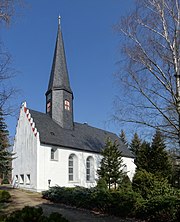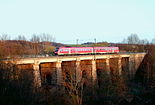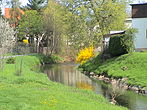Langenhessen
|
Langenhessen
Major district town of Werdau
Coordinates: 50 ° 46 ′ 3 ″ N , 12 ° 22 ′ 16 ″ E
|
||
|---|---|---|
| Height : | 262 (250-320) m | |
| Area : | 10.19 km² | |
| Residents : | 1886 (1994) | |
| Population density : | 185 inhabitants / km² | |
| Incorporation : | January 1, 1997 | |
| Postal code : | 08412 | |
| Area code : | 03761 | |
|
Location of Langenhessen in Saxony |
||
Langenhessen is a district of the large district town of Werdau in the district of Zwickau in Saxony . It was incorporated into Werdau on January 1, 1997.
geography
location
Langenhessen is located in the Pleiße valley , between the city of Werdau and the municipality of Neukirchen, in the Erzgebirge foothills and in the west of the Erzgebirge basin . The Koberbach dam is to the northwest of the village .
Neighboring places
| Niederalbertsdorf | Neukirchen | Lauterbach |
| Langenbernsdorf |

|
Königswalde |
| Werdau |
history
The place was first mentioned in 1270 as "Hessen" and in 1551 as Langenhessen. The majority of the first settlers at this point came from the state of Hesse , probably from the western slope of the inhospitable Hohe Rhön . But there were also settlers from the eastern Franconian region and from Bavaria . At the time of its foundation, the place belonged to the governors of Weida . Heinrich von Weida donated it together with the church income to the Martinstal Charterhouse near Crimmitschau . The settlement took place in several waves. The farms were laid out as so-called forest hooves on both sides of the Pleiße.
Langenhessen suffered repeatedly from plague epidemics in the last years of the 16th century and in the first years of the 17th century , especially in 1633. Even the Thirty Years' War did not go by without a trace. In 1633 Wallenstein von Zwickau moved against Sweden, whereby Langenhessen also suffered a lot. In addition, Langenhessen was hit by the witch hunt around 1659 . Anna, wife of Bernhard Seidel, got involved in a witch trial.
The main branches of business in the village were initially agriculture and rural handicrafts . With the beginning of industrialization , many people found work in the newly founded textile and woodworking companies . Until the 19th century, the manorial rule over Langenhessen was part of several manors and churches. As an administrative village, part of it was directly subordinate to the Zwickau office. Until 1856 Langenhessen belonged to the Electoral Saxon or Royal Saxon Office of Zwickau . In 1856 Langenhessen was affiliated with the Werdau court office and in 1875 with the Zwickau administration . In 1920 Langenhessen was assigned to the Werdau administration . With the dissolution of the Werdau administrative authority, the municipality of Langenhessen came back to the Zwickau administrative authority in 1933, which from 1939 was called the Zwickau district.
By the second district reform in the GDR the community Langenhessen came in 1952 to the district Werdau in the district of Chemnitz (1953 in Karl-Marx-Stadt district renamed), which was from 1990 continued as Saxon district Werdau and 1994 in Zwickau county land , located of the district administrator in the large district town of Werdau. After the renovation and decommissioning of the Werdau district hospital (1978–1999; then operated as a Pleißental clinic on the opposite side of the town with its own bus and train stop in Werdau Nord), the new district office went into operation there in 1999, including a new extension with a district assembly room to the former hospital canteen. The old district came back to the newly founded district of Zwickau in 2008. On January 1, 1997, Langenhessen was incorporated into the large district town of Werdau, Werdau district.
Attractions
church
When the church was built cannot be determined exactly, probably around 1208. It was originally consecrated to John the Baptist , whose figure can also be found on the altar. As can be seen in the whole building, only part of the church originally stood, today's chancel. The current nave was added later. According to an old legend, the oldest part of the church is said to have been a pilgrimage chapel dedicated to John the Baptist . With the pastor Balthasar Thürschmidt, the Reformation also took place in Langenhessen around 1517 .
The church tower, a slender, pointed roof turret , received a bell consisting of three bells in 1882. The church clock was also purchased in 1882. The bells had to be handed in to the military during the First World War in 1917 , but today's steel bells were inaugurated in 1919. The organ , built by Johann Gotthilf Bärmig in 1855 , was damaged by a lightning strike in the church tower in 1885 and repaired in 1889 by the organ builder Georg Emil Müller from Werdau. It was rebuilt in 1919 by the Schmeisser (Rochlitz) company and given a general overhaul in 1997. Inside the church there is a convertible altar from the workshop of Leonhardt Herrgott , Zwickau (1507/1508).
Koberbachtalsperre
To the northwest, on the border with Langenbernsdorf, lies the Koberbach dam . Built as a process water dam, it is used today for flood protection and offers many opportunities for recreation as a swimming lake, with an outdoor pool, camping and drive-in cinema.
Railway viaduct
The Langenhessen railway viaduct on the Leipzig – Hof railway line is a historical monument . It was built on two tracks from 1842 to 1845 with a 171.31 meter row of vaults.
Personalities
- Gotthard Schuster (1674–1761), Protestant theologian and hymn poet
- Siegfried Leberecht Crusius (1738–1824), bookseller and publisher
literature
- The ephorie Werdau . In: Neue Sächsische Kirchengalerie , Arwed Strauch, Leipzig 1905 digitized , chapter: Die Parochie Langenhessen page 218 ff.
- Free press of September 21, 2016 Langenhessen has a lot of Hesse and Bavaria
Individual evidence
- ↑ Werner Querfeld : The oldest written mentions of the places in the Werdau district, in: Regional historical contributions from the Karl-Marx-Stadt district , volume 3, Karl-Marx-Stadt 1981, p. 74.
- ↑ Manfred Wilde : The sorcery and witch trials in Kursachsen , Cologne, Weimar, Vienna 2003, p. 633f.
- ^ Karlheinz Blaschke , Uwe Ulrich Jäschke : Kursächsischer Ämteratlas. Leipzig 2009, ISBN 978-3-937386-14-0 ; P. 64 f.
- ↑ The Zwickau administrative authority in the municipal register 1900
- ^ Michael Rademacher: German administrative history from the unification of the empire in 1871 to reunification in 1990. City and district of Zwickau. (Administrative structure in the Zwickau area around 1939; online material for the dissertation, Osnabrück 2006).
- ↑ Langenhessen on gov.genealogy.net
Web links
- Langenhessen in the Digital Historical Directory of Saxony









